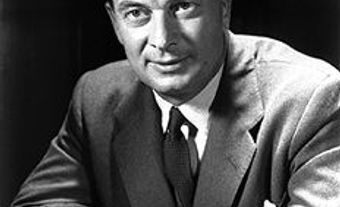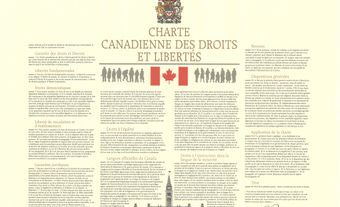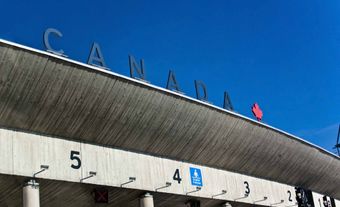Canada’s federal multiculturalism policy was adopted in 1971 by Pierre Trudeau’s Liberal government. An unexpected by-product of the Royal Commission on Bilingualism and Biculturalism (1963–69),
multiculturalism was intended as a policy solution to manage both rising francophone nationalism, particularly in Quebec (see
French-Canadian Nationalism; The Quiet Revolution), and increasing cultural diversity across the country. Canada was the first country in the world to adopt a multiculturalism
policy. The federal multiculturalism policy marked its 50th anniversary in 2021.
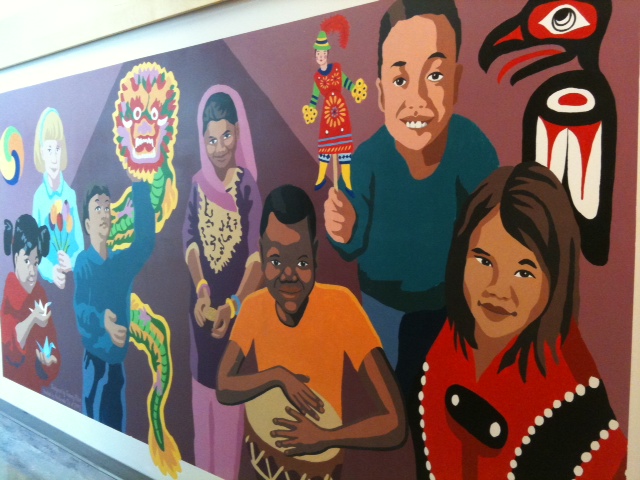
Background
The initial idea behind multiculturalism was brought to popular attention by John Murray Gibbon’s 1938 book Canadian Mosaic: The Making of a Northern Nation, which challenged the US-born idea of cultural assimilation, known as the “melting pot.” However, it was not until the 1960s that multiculturalism emerged as an object of national conversation about Canadian identity.
The Royal Commission on Bilingualism and Biculturalism
The origins of Canada’s multiculturalism policy can be found in the Royal Commission on Bilingualism and Biculturalism (1963–69).
The Royal Commission on Bilingualism and Biculturalism was appointed to investigate the state of bilingualism and biculturalism in Canada. The commission was a response to the growing unrest among French Canadians in Quebec, who called for the protection of their language and culture, and opportunities to participate fully in political and economic decision making (see Quiet Revolution). The commission's findings led to changes in French education across the country, the creation of the federal ministry of multiculturalism and the Official Languages Act (1969).
Two years later, in 1971, Canada’s multiculturalism policy was adopted. The policy acknowledged that Canadians come from a wide variety of cultural backgrounds, and that all cultures have intrinsic value. In a speech in the House of Commons in April of 1971, Prime Minister Pierre Trudeau introduced it as “a policy of multiculturalism within a bilingual framework,” a policy that would complement the Official Languages Act by facilitating the integration of new Canadians into one or both of the official language communities. “Although there are two official languages, there is no official culture,” said Trudeau.
Multiculturalism was not welcomed by everyone. Opposition to the federal multiculturalism policy was strongest in the province of Quebec.
Evolution of Multicultural Policy in Canada
Federal multicultural policies and programs have evolved considerably since they were first introduced in 1971.
Ethnicity Multiculturalism (1970s)
The initial approach taken by the government might be described as “ethnicity multiculturalism.” During the early 1970s, financial assistance was extended to certain ethno-cultural organizations for the promotion of cultural heritage. Modest support was provided for folkloric and artistic ethno-cultural expression.
Early opponents of federal multiculturalism argued the program discouraged social integration. Some charged that the real purpose of the funding was to secure political support from ethnic minority populations. Despite such criticisms, multiculturalism remained popular with Canadians, though to a lesser extent in Quebec.
Equity or Rights-Based Multiculturalism (1980s)
Prior to 1970, much of Canada’s immigration was from European countries. However, the Immigration Act of 1976 lifted some restrictions on immigration from non-European countries (see Immigration Policy in Canada). The ensuing shift in demographics prompted calls to rethink multicultural policies with a focus on the need to combat discrimination. There were also calls to move away from supporting the cultural and/or folkloric expression of ethnic groups. As a result, equity or rights-based multiculturalism increasingly defined the policies and programs of the 1980s.
The 1982 patriation of the Canadian Constitution added a Charter of Rights. Section 27 stipulated that the Charter “shall be interpreted in a manner consistent with the preservation and enhancement of the multicultural heritage of Canadians.” While the section created a basis for how other sections might be applied, it did not provide a legislative framework for multicultural policy and therefore did not prescribe what government had to do to implement and advance multiculturalism. But many Canadians began to associate multiculturalism with other basic and rights and freedoms enshrined in the Charter, such as freedom of expression and freedom of religion.
However, the Quebec government did not sign the 1982 Constitution. And so, in 1987, Prime Minister Brian Mulroney’s Conservative government sought the agreement of all provinces to amend the constitution with an offer of recognition for Quebec’s distinct character (“distinct society”). Known as the Meech Lake Accord, the proposed constitutional amendment also called for the recognition of official language minorities, including the “recognition that the existence of French-speaking Canadians…constitutes a fundamental characteristic of Canada.” Meech Lake did not affect any of the provisions of the constitution that relate to Indigenous peoples in Canada or section 27 of the Charter, which related to multiculturalism (see also Meech Lake Accord: Document).
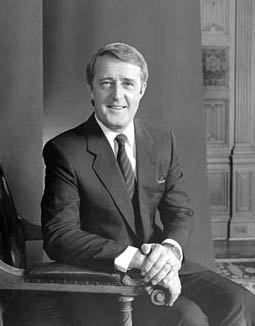
The Accord failed to secure the required consent of all provinces. Nevertheless, in 1988 the federal government passed the Multiculturalism Act (Bill C-93). It was aimed at promoting “the full and equitable participation of individuals and communities of all origins in the continuing evolution and shaping of all aspects of Canadian society.”
In the late 1980s, concerns resurfaced about Canadian unity. Some opponents of multiculturalism believed that ethnic minority attachments to the cultures of their countries of origin were the main threat to Canadian identity. In their view, multiculturalism encouraged divisive dual and multiple identities and, in so doing, prevented citizens from simply describing themselves as Canadians.
Anti-Racism/Anti-Discrimination Multiculturalism (1990s)
During the 1990s, federal multiculturalism policies and programs placed greater emphasis on eliminating barriers to economic and social participation of immigrants and designated minority groups. In 1995, the federal government passed employment equity legislation that, among other things, required that information be gathered in order to determine the degree of the underrepresentation of persons in designated groups, notably the country’s visible minorities. Since 1996, the census has collected information about visible minorities in Canada and multiculturalism aimed at eliminating racism and discrimination, assisting institutions to become more responsive to Canada’s diversity.
Public Discourse on Canadian Multiculturalism
There are many examples of critics and champions of multiculturalism in Canada. Here are two:
Neil Bissoondath
With his 1994 publication Selling Illusions: The Cult of Multiculturalism in Canada, author Neil Bissoondath emerged as one of Canada’s most outspoken public critics of multiculturalism. He argued that the policy undermined Canada’s bicultural nature and thereby undermined Canadian identity (see Canadian Identity and Language). He insisted that the encouragement of ethnic differences led immigrants to adopt a “psychology of separation” which created distinct communities and prevented newcomers from becoming fully part of the mainstream culture. He suggested that this threatened Canadian unity and cohesion.
Will Kymlicka
With his 1995 book Multicultural Citizenship: A Liberal Theory of Minority Rights, philosopher Will Kymlicka emerged as one of the leading proponents of multiculturalism. He articulated a typology of minority rights, which includes self-government rights (for Quebec), special representation rights (for Indigenous peoples) and polyethnic rights (which he defines as legal and financial support for the protection of specific cultural practices). In a later publication, Finding Our Way: Rethinking Ethnocultural Relations in Canada (1998), Kymlicka presented evidence that multiculturalism did not decrease the rate of immigrant integration. Using data on naturalization rates for immigrants, levels of political participation among ethnocultural groups, and rates at which new Canadians can speak an official language and rates of intermarriage, Kymlicka argued that the multiculturalism policy has worked, and that there is no evidence that it has promoted ethnic separateness.
Multiculturalism in Quebec
Initial Rejection of Multiculturalism in Quebec
As mentioned earlier, multiculturalism was not welcomed by everyone in Canada. Opposition to the federal multiculturalism policy was strongest in Quebec, the only province in which French is the majority language. For example, premier Robert Bourassa insisted that the federal policy was founded on a questionable dissociation of culture from language. He argued that the policy of multiculturalism was not suited to the majority-French province. Claude Ryan, then-publisher of the Quebec French-language newspaper Le Devoir, warned that federal multicultural policy challenged the recognition of Canada’s two founding peoples (the English and the French). Many Quebecers expressed concerns that multiculturalism seemed to place French culture on an equal footing with all other ethno-cultural groups.
Charter of the French Language (1977)
In 1977, the government of Quebec introduced the Charter of the French language (Bill 101) which made French the province’s official language. In contrast with the federal model of multiculturalism within a bilingual framework, Bill 101 was described as unilingual and culturally pluralist. In an article titled “Ethnic Minorities in the New Québec” published in 1978, Camille Laurin, Bill 101’s chief architect, explained that in order to live together in the same nation, different ethnic groups must be able to speak and understand each other using French as the common language. “Hence,” he added, “a national language and common culture are useful, although they do not preclude the continued use of ethnic languages and maintaining of individual cultures.”
Bill 101 addressed a widely held concern among many francophones that without language legislation, newcomers would inevitably integrate into the English-speaking community while selectively retaining their ethnic identities. In 1978, under the Cullen/Couture agreement, the government of Canada transferred responsibility to the Quebec government for the selection of economic immigrants and the province thus assumed increased authority for programs in the area of newcomer integration and cultural retention (see Quebec Immigration Policy.)

“Many Ways of Being a Quebecer” (1981)
Under Premier René Lévesque, in 1981 the Parti Québécois formally rejected federal multiculturalism. In its place, the government of Quebec proposed a policy of “cultural convergence.” The policy was entitled “Many ways of being a Quebecer.” Its principal objective was to “ensure the maintenance and development of cultural communities and their specificities, make French-speaking Quebecers aware of the contribution of cultural communities to our common heritage and finally promote the integration of cultural communities in Quebec society and especially in sectors where they are particularly underrepresented.”
Some critics suggested that the Quebec government’s policies and programs regarding the province’s ethno-cultural communities looked somewhat like multiculturalism in the French language, and thus resembled what the federal government had introduced in the previous decade.
The Bouchard-Taylor Commission on Reasonable Accommodation (2007–08)
In Quebec, the public discussion over the accommodation of religious diversity has been especially vocal. In 2007 Liberal Premier Jean Charest announced the creation of a provincial Commission to investigate the issue of accommodating cultural and religious differences. Over several months, Commission co-chairs Gérard Bouchard and Charles Taylor heard public testimony from Quebec francophones denouncing multiculturalism.
In their report, the Commissioners noted that “multiculturalism is presented as though it solely takes into account recognition and affirmation of difference with no regard for integrating elements such as the teaching of national languages and intercultural exchange programs. It is this truncated version of multiculturalism that often prevails in Quebec, as though this model had not evolved in Canada since its adoption nearly 40 years ago.”
The Commissioners concluded that the Canadian multiculturalism model was not well adapted to conditions in Quebec. They proposed that Quebec opt for a model of interculturalism with the stated intention of “reconcil[ing] ethnocultural diversity with the continuity of the French-speaking core.” Through the institution of French as the “common public language” of Quebec and promoting cross-cultural interaction, an intercultural model was said to “afford security to Quebecers of French-Canadian origin and to ethno-cultural minorities and protects the rights of all, in keeping with the liberal tradition.” They also pointed to the need to clearly define the lines of separation of religion from government. The Commissioners recommended a ban on persons wearing religious symbols in what were referred to as positions of authority, notably judges, Crown prosecutors, prison guards and police officers. Nine years after the Report was issued, co-chair Charles Taylor revisited his stand and argued that such a ban was no longer required.
Multiculturalism in the Early 21st Century
Most Canadians think of multiculturalism as a demographic reality that acknowledges the diverse ethnic makeup of the Canadian population. However, there is ongoing debate over the message that multicultural policy conveys to Canadians, particularly to immigrants.
Over its first 30 years, the principal challenges confronting multiculturalism involved reconciling support for ethnic diversity, the preservation of the French language and the promotion of Canadian identity. While such debates have persisted into the 21st century, they’ve largely given way to the view that the message of multiculturalism promotes excessive accommodation of cultural and religious diversity at the expense of promoting social cohesion and common values. Others see the multicultural message as discouraging newcomers from adopting Canadian values. This, in turn, makes them less likely to participate in the mainstream culture and society and encourages the creation of ethnic ghettos.
In recent years, there has been a greater acknowledgement and acceptance of mixed and multiple identities in Canada. While most Canadians appear favourable to the ideal of multiculturalism, research suggests that support for the accommodation of religious diversity is more divided.

 Share on Facebook
Share on Facebook Share on X
Share on X Share by Email
Share by Email Share on Google Classroom
Share on Google Classroom
.jpg)
